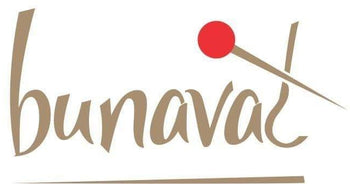I could not have been more excited about the trip to the Rann of Kutch! There was, definitely, the excitement of seeing the white Rann, but I must admit that my secret plan of stealing some time from the vacation to visit Ajrakhpur contributed much more to that excitement. Having an equally enthusiastic husband surely makes such escapades more fun.
After an early trip to the Rann to witness the magnificent sunrise, we bid farewell to our friends and set off for Ajrakhpur. It is about an hour and forty-five minutes drive from Dhordo. Owing to my Eastern-India origin, I have always associated villages with an abundance of greenery, well-irrigated lands and harvest festivals. However, the villages we traversed to reach Ajrakhpur were visually very different; arid and with sparse vegetation. That stark contrast still perturbs me.
As our car entered Ajrakhpur, we were greeted by children in blue uniforms, playing outside a school, most of which had been dug up. The sparkle in their eyes and the joy in their voices were like warm hugs on a winter morning. As we stepped into Ismail Bhai’s warehouse, we were greeted warmly by his wife and year-old son. I was immediately floored by the collection of natural dyed Ajrakhs, in cotton, silk and khadi carefully stacked on the racks. Did I not mention, Ajrakh is my all-time favourite print!
We drove with him to his printing workshop, a couple of blocks away. With extreme patience, he explained the extremely laborious 17 stage process of Ajrakh printing. Using natural colors from madder, rusted iron, tamarind, dried flowers, he and his small team bring to life those incredible colors on cloth. The boiling of the fabric in large containers is an important part of the process, and the image of Chacha doing that with a smile in the heat is something that will always stay with me. All of these were captivating enough, but what stole the show were printing blocks, which were 200 years old. We learned how those blocks are sturdier than the ones made these days, and thus have lasted this long. When he handed me one of his great grandfather’s block, I was humbled to have held that little piece of history.
Ismail bhai’s family has been in this business for generations. However, the business had never been profitable; he recalls his father earning just Rs.2 per saree for such a laborious and time-consuming process. At an early age, he realized, Ajrakh printing would not suffice his family’s financial needs and so he took up a job in Mumbai. They closed down the business. The job gave him stability and more money, however, the revival of the art always remained on his mind.
After quite a few years, he returned to Ajrakhpur, and despite his father’s disapproval, he restarted Ajrakh printing. It was heartening to hear him speak of innovation and creativity and how he constantly thinks of new designs, combining the traditional with the modern, and wants to stay relevant. He also adds, that though the conditions are better than before, they are still not convincing enough to motivate his brother to join this business.
Like Ismail Bhai, many weavers have quit their age-old family-run businesses in search of newer, financially better and more stable opportunities. Not every person would have his conviction to return back to the craft. Whatever he shared, whatever I witnessed and whatever was never said, left me more desirous of someday returning back to this place, to soak in the richness of the people, and learn more of all that remains to be unraveled, yet.
His dad has numerous stories to share as well, which I will save for another blog.
